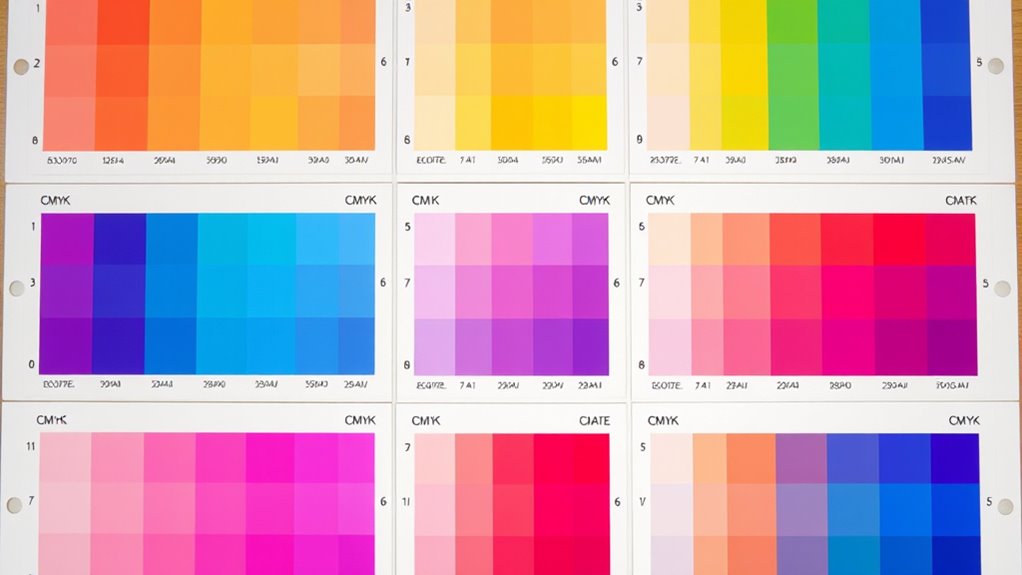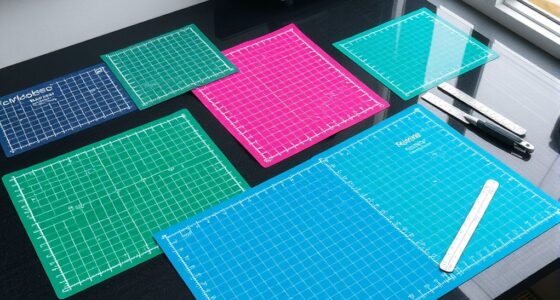When searching for the 12 best CMYK color charts, I focus on those offering accurate, durable, and all-encompassing references. Options like the Pantone Color Bridge Guide and the Pantone CMYK Guide Set provide precise color matching with physical and digital data, while others like the CMYK Charts Book and Color Card offer extensive swatches for calibration. Considering durability, color range, and ease of use helps me pick the right tools—keep exploring to find the perfect fit for your needs.
Key Takeaways
- Choose charts that adhere to ISO 12647-2 standards and include print-tested swatches for consistent color accuracy.
- Prioritize extensive color ranges with thousands of CMYK swatches, including gradients and tints for precise hue matching.
- Opt for durable, waterproof, and coated materials to ensure longevity and reliable performance in professional printing environments.
- Look for charts with clear organization, visual swatches, and comprehensive data like CMYK, Hex, RGB, and media-specific information.
- Consider calibration features such as G7 compliance and verified color matching to achieve consistent, high-quality print results.
Design Swatch A CMYK and Pastels Color Reference Guide

If you’re a graphic designer or small business owner looking for a reliable CMYK color reference, the Design Swatch A CMYK and Pastels Color Reference Guide is an excellent choice. It includes 50 cards with 300 carefully selected, print-ready CMYK colors, ensuring accurate reproduction on real-world printers. Each card features both CMYK and Hex codes, making digital-to-print conversion seamless. Designed for professional use, these colors are tested for consistency and usability, helping you create vibrant, accurate designs. Compact and lightweight, this guide is perfect for on-the-go projects, whether in the studio or the field.
Best For: graphic designers and small business owners seeking a reliable, print-ready CMYK color reference guide for accurate color matching and efficient workflow.
Pros:
- Provides 300 carefully curated, print-ready CMYK colors for professional-quality output.
- Includes both CMYK and Hex codes for seamless digital and print conversion.
- Compact, lightweight design makes it easy to carry and use on-the-go.
Cons:
- Limited to 50 cards, which may not cover all color needs for very large projects.
- Does not include RGB or Pantone color references for broader digital or branding use.
- The deck’s focus on print colors might be less useful for strictly digital design projects.
Pantone Color Bridge Guide Coated

Looking for a reliable tool to guarantee perfect color matching across various design projects? The Pantone Color Bridge Guide Coated is an excellent choice. It features 2,359 colors printed on coated paper, including 224 trend-relevant graphics colors. The guide provides CMYK, HTML, and RGB values, making it easy to translate Pantone Spot colors into digital and process printing formats. Its handheld fan deck design allows for quick comparison and accurate color evaluation under different lighting conditions, thanks to its lighting indicator page. This guide is ideal for graphic, branding, packaging, and digital designers aiming for precise color consistency across all media.
Best For: graphic, branding, packaging, digital, video, and web designers seeking accurate and consistent color matching across various media.
Pros:
- Includes 2,359 colors with 224 trend-relevant graphics colors for versatile use
- Provides CMYK, HTML, and RGB values for precise digital and process printing matching
- Features a lighting indicator page for evaluating lighting conditions during color assessment
Cons:
- Designed for indoor use only on coated paper surfaces, not waterproof or water-resistant
- Relatively heavy at 1 pound, which may be less portable for on-the-go use
- Limited to printed color references; does not include digital app or online access
Pantone CMYK Guide Set

The Pantone CMYK Guide Set stands out as the ideal choice for designers, printers, and artists who need accurate and all-encompassing color matching in four-color process printing. It offers 2,868 chromatically organized CMYK colors, including coated and uncoated options, making color selection straightforward without relying on spot colors. The set features G7-calibrated tint values for precise matching, printed on durable, water-resistant paper. Its compact, user-friendly design includes a color index and lighting evaluation tool, supporting environmentally friendly practices with ISO-certified inks. Whether indoors or outdoors, this guide guarantees consistent, reliable color reproduction across various media.
Best For: graphic designers, printers, and artists seeking precise, comprehensive color matching in four-color process printing for professional and creative projects.
Pros:
- Offers 2,868 chromatically organized CMYK colors for easy selection
- Includes G7-calibrated tint values for accurate color matching under G7 conditions
- Printed on durable, water-resistant paper supporting indoor and outdoor use
Cons:
- Slightly heavier and larger than some compact color guides, which may impact portability
- Not fully waterproof, so additional care is needed in wet environments
- Price may be higher compared to basic CMYK guides due to extensive color options
CMYK Color Charts Reference Guide Book
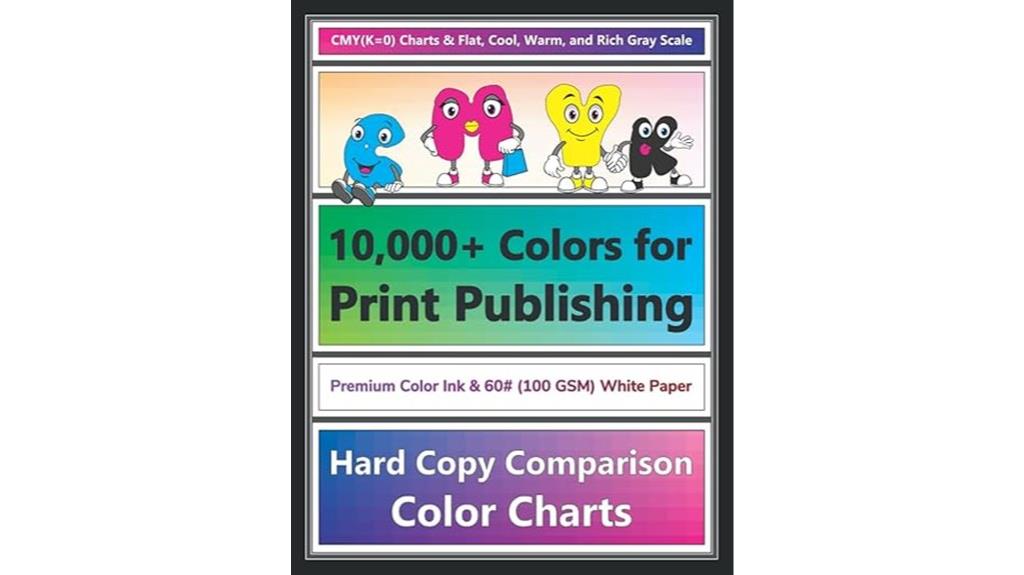
The CMYK Hard Copy Color Charts book is perfect for print publishers who need precise physical color swatches, focusing on CMY values in detailed 5% increments. It offers over 10,000 colors arranged in tables that fix Cyan at 5% steps, while Magenta and Yellow vary from 0–100% in 5% increments. This makes it an excellent reference for matching colors in print production. However, it doesn’t include RGB or hex values, limiting its usefulness for digital design or conversions. Personally, I find this book less helpful for self-publishers compared to RGB to CMYK charts, but it’s invaluable for accurate physical color matching.
Best For: print publishers and professionals who require precise physical CMY color swatches for accurate color matching in print production.
Pros:
- Provides over 10,000 detailed CMY color swatches in consistent 5% increments
- Ideal for physical color matching and print calibration purposes
- Focuses exclusively on CMY values, offering comprehensive print color reference
Cons:
- Lacks RGB and hex values, limiting digital color conversion and application
- Less useful for digital designers or for projects requiring digital color matching
- Not suitable for those needing integrated digital color reference or software compatibility
4-Color CMYK Color Card for Printing and Design
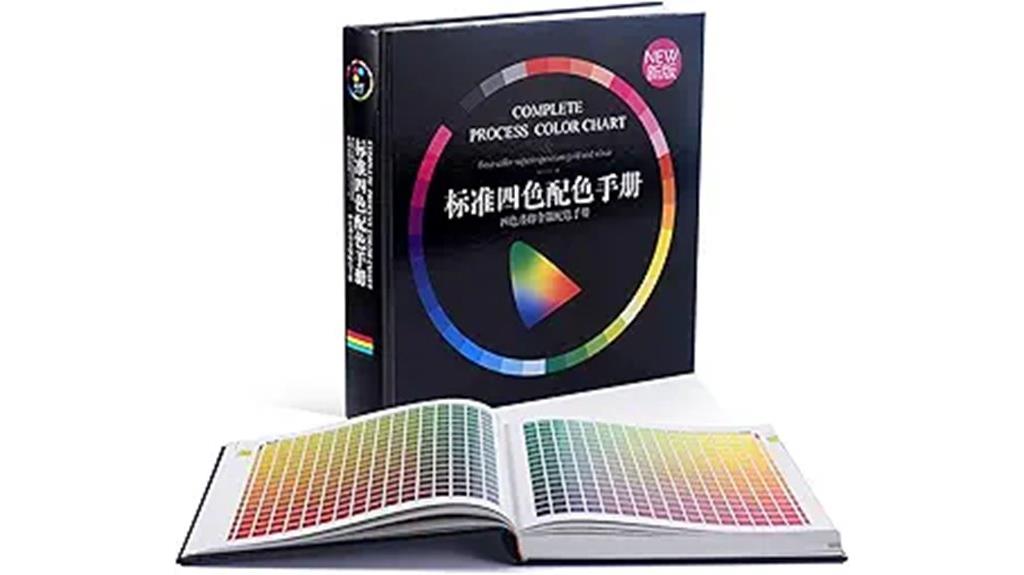
If you’re a designer or print professional seeking precise color matching, the 4-Color CMYK Color Card stands out as an essential tool. It features around 83,234 CMYK colors, making it highly extensive for accurate reproduction. Printed on 200g coated paper with an elegant design, it’s durable and easy to handle. The card helps control color accuracy from digital design to the final print, reducing errors and ensuring consistency. Suitable for graphic, interior, industrial design, and printing industries, it streamlines workflows. Manufactured by STMKB, it combines professional quality with reliable customer support, making it a valuable reference in any color-critical project.
Best For: designers, print professionals, and students who need precise and extensive color matching for graphic, interior, industrial design, and printing projects.
Pros:
- Contains approximately 83,234 CMYK colors for comprehensive color matching.
- Durable, high-quality construction with 200g coated paper and elegant design.
- Facilitates accurate color control from digital design to final print, improving workflow efficiency.
Cons:
- The large number of colors may be overwhelming for users seeking quick reference.
- The high volume and detailed palette could be costly for casual or infrequent use.
- Requires familiarity with CMYK color systems for optimal utilization.
The Color Wheel Company CMY Primary Mixing Wheel W/Workbook
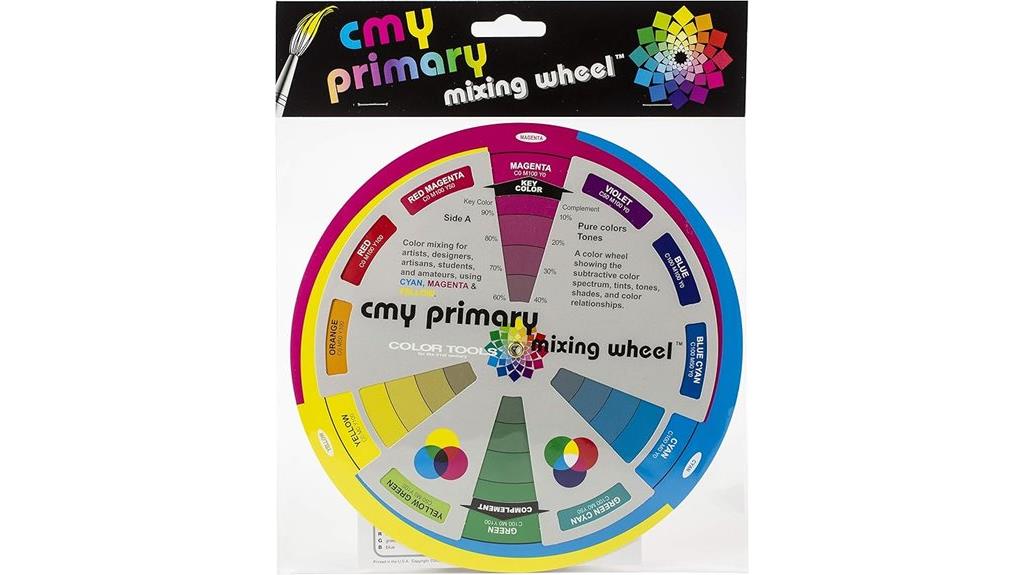
Designed for students, teachers, and hobbyists, the Color Wheel Company CMY Primary Mixing Wheel with Workbook offers a hands-on way to understand color relationships. This 8×9.75-inch dual-sided tool visually demonstrates how colors mix, showing results with black, white, and various tints and tones. One side features a color mixing wheel, while the other highlights harmonious schemes like analogous and complementary colors. It also includes a grayscale and definitions of key color terms. The package comes with a workbook for guided learning, making it an excellent resource to deepen your grasp of color theory and improve your color blending skills.
Best For: art students, teachers, and hobbyists seeking a practical, visual tool to understand color mixing and harmony.
Pros:
- Provides a clear, visual demonstration of color mixing with black, white, and tints/tones.
- Includes both a color wheel and harmony schemes like analogous and complementary colors for comprehensive learning.
- Comes with a workbook for guided practice, enhancing understanding of color theory concepts.
Cons:
- Slightly limited to educational and hobbyist use; may not suit professional artists needing advanced tools.
- The size (8×9.75 inches) may be too small for detailed color work.
- No warranty information specified, which might concern some buyers.
RGB to CMYK Color Charts for Self-Publishers
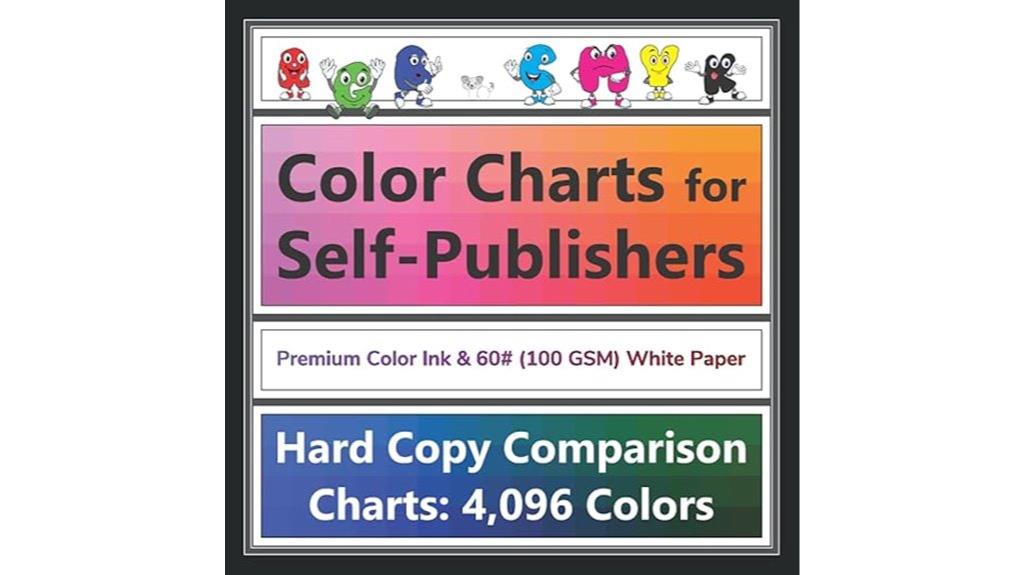
Self-publishers seeking a broad spectrum of color codes will find the “12 Best CMYK Color Charts” helpful, especially when working with RGB to CMYK conversions. This particular chart offers 4,096 colors as a reference guide, ideal for hobbyists and casual self-publishers. However, it isn’t designed for professional use; it lacks detailed color analysis and precise printing guidance. The colors are arranged illogically, making it frustrating to locate specific formulas or understand color relationships. While useful for quick code references, it doesn’t visually compare RGB and CMYK results, limiting its effectiveness for accurate color matching or professional projects.
Best For: hobbyists and casual self-publishers needing a large variety of color codes for reference rather than precise color matching.
Pros:
- Offers a comprehensive palette of 4,096 colors for broad reference.
- Useful for quick lookup of RGB and CMYK color codes.
- Suitable for basic projects where exact color matching is not critical.
Cons:
- Colors are arranged illogically, making navigation frustrating.
- Lacks visual comparison of RGB and CMYK colors in printed form.
- Not suitable for professional applications requiring detailed color analysis or accurate printing guidance.
Cmy Primary Mix Color Wheel,Multicolored

Looking for a practical tool to master color mixing? The Cmy Primary Mix Color Wheel, Multicolored, is perfect for that. It visually shows how to create secondary and tertiary colors using cyan, magenta, and yellow primaries, which are true watercolors. The wheel features tints, shades, and tones of 12 colors, highlighting color relationships and harmonies. Its two-sided design offers multiple stops for detailed mixing guidance. Compact and portable, it’s ideal for artists, students, and hobbyists to improve color blending and selection. Whether indoors or outdoors, this tool makes understanding color theory accessible and straightforward, helping you achieve more accurate and vibrant results.
Best For: artists, students, and hobbyists seeking an easy-to-understand, portable tool to learn and improve color mixing and theory.
Pros:
- Visually demonstrates how to create secondary and tertiary colors from true primary pigments cyan, magenta, and yellow
- Compact, portable, and easy to use for both indoor and outdoor activities
- Shows a variety of tints, shades, and tones to enhance understanding of color relationships and harmonies
Cons:
- Some users find it feels somewhat cheap or thin in quality
- Not waterproof, limiting use in certain conditions or water-based projects
- Could benefit from additional features like a terminology key or thicker material for durability
Color Index XL: New Palettes for Designers and Artists
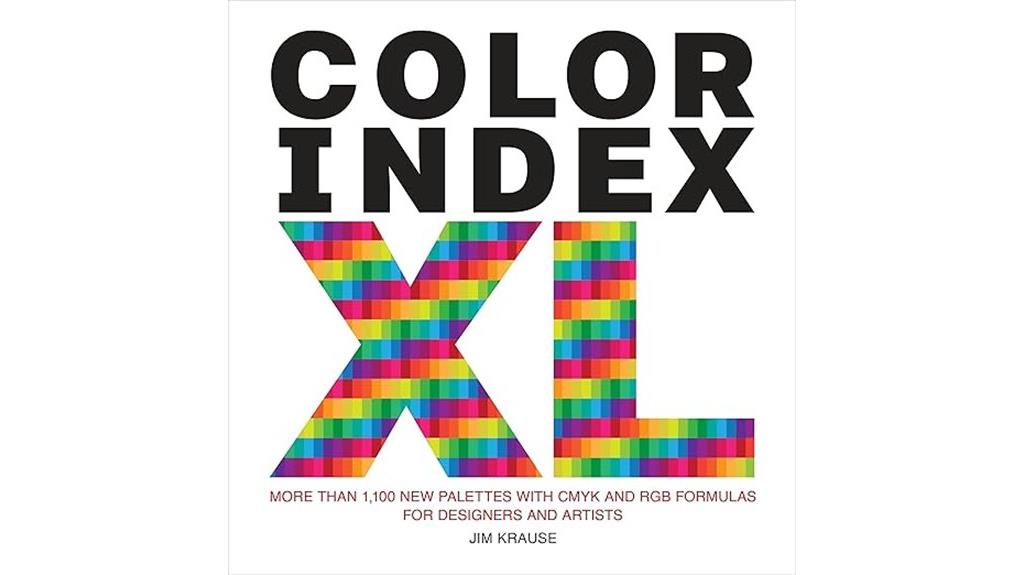
Color Index XL stands out as an essential resource for designers and artists who want quick access to reliable, all-encompassing color palettes in CMYK and RGB formats. With over 1,100 new palettes, it offers a comprehensive reference that boosts confidence in color selection and harmony. The book categorizes palettes into warm, mixed, and cold tones, making it easy to find suitable schemes for any project. Users praise its practicality, inspiring experimentation across digital and traditional media. Whether planning fashion, interior design, or illustration, this guide helps save time and enhances creativity, making it a must-have tool for professionals seeking dependable color inspiration.
Best For: creative professionals, designers, and artists seeking a comprehensive, reliable reference for CMYK and RGB color palettes to enhance their projects.
Pros:
- Extensive collection of over 1,100 new palettes with clear CMYK and RGB formulas
- Categorized into warm, mixed, and cold tones for easy navigation and selection
- Inspires experimentation and improves color harmony across digital and traditional media
Cons:
- Some users have experienced issues with physical condition upon delivery, such as scratches or torn pages
- The large edition may be less portable for on-the-go use
- Does not replace Pantone, so it may not suit all professional color matching needs
Color Index: Over 1100 Color Combinations for Print and Web

The Color Index with over 1100 color combinations is an essential tool for designers, print professionals, and creative enthusiasts seeking reliable, versatile palettes for both print and web projects. I’ve used it extensively in publishing, where choosing the right colors made a real difference—helping my covers stand out and boosting sales. The book’s visual schemes and clear CMYK and RGB data simplify digital and print reproduction, saving time and reducing errors. It’s also great for inspiration across fields like jewelry, fashion, and home decor. The practical, easy-to-understand layouts make it a go-to resource for experimenting with color combinations that look vibrant and professional.
Best For: graphic designers, publishers, and creative enthusiasts looking for reliable, versatile color palettes for print and web projects.
Pros:
- Offers over 1100 carefully curated color combinations with clear visual schemes and precise CMYK and RGB formulas.
- Enhances creativity and helps avoid repetitive color choices, inspiring experimentation across various creative fields.
- Affordable alternative to high-cost Pantone guides, with easy-to-use layouts suitable for quick reference.
Cons:
- Primarily focused on American-style color schemes, which may appear overly vibrant or lively for some users.
- Some editions, such as the Japanese version, include language considerations that might require familiarity with English or additional translation.
- Not a comprehensive digital color management tool but rather a visual reference, requiring supplementary tools for advanced color matching.
Color Charts XL: Color Collection Edition
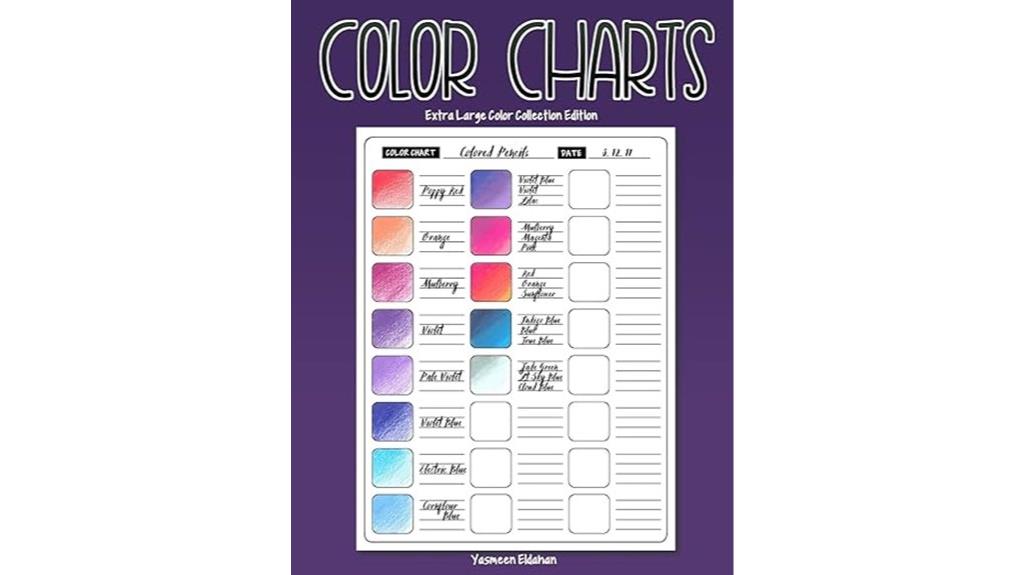
For artists and color enthusiasts who need ample space to track, organize, and experiment with a wide range of hues, Color Charts XL: Color Collection Edition stands out as an ideal choice. This large, soft-cover book offers 80 sheets with 24 sizable (1-inch) color squares per page, perfect for blending, shading, and creating palettes. Its thick, slightly textured paper works well with colored pencils, gel crayons, and ink, though heavy markers may bleed through. The included lines allow for detailed recording of color information, making it a versatile tool for managing collections and exploring color relationships. Its generous size and capacity make it invaluable for dedicated color work.
Best For: artists, color enthusiasts, and designers who require extensive space for color tracking, blending, and organization across various media.
Pros:
- Large 80-sheet capacity with 24 sizable color squares per page provides ample space for detailed work and comparisons.
- Thick, smooth paper suitable for colored pencils, gel crayons, and ink, facilitating easy blending and application.
- Single-sided pages prevent bleed-through, making it ideal for use with markers and heavy media.
Cons:
- Thin paper may bleed through or dampen with heavier, alcohol, or water-based markers, requiring protective sheets.
- The size and weight of the book may be cumbersome for portable use or frequent handling.
- Some users wish for thicker, more durable paper to better accommodate markers and prolonged use.
The Complete Color Harmony, Pantone Edition

If you’re looking to deepen your understanding of color harmony with a focus on vibrant, contemporary palettes, the Complete Color Harmony, Pantone Edition is ideal for designers, artists, and hobbyists. This series has evolved since 1987, expanding from traditional themes to include diverse palettes used in fashion, interior design, and fiber arts. It offers insightful chapters on color theory, psychology, and mood, helping you grasp how color influences emotions and personality. The books feature extensive Pantone-linked palettes, vibrant visuals, and practical guidance for applying colors across various projects. Overall, it’s a valuable resource for inspiring creativity and achieving harmonious, impactful color schemes.
Best For: designers, artists, and hobbyists seeking vibrant, contemporary color palettes and practical guidance for various creative projects.
Pros:
- Extensive Pantone-linked palettes provide accurate and inspiring color options.
- High-quality, vibrant visuals enhance understanding and spark creativity.
- Comprehensive sections on color theory and psychology deepen knowledge and application skills.
Cons:
- Some editions may have printing or paper quality issues, affecting color fidelity.
- The ring format for color palettes can be distracting due to white space.
- The books’ layout and presentation vary, which might require adaptation for different projects.
Factors to Consider When Choosing CMYK Color Charts for Printers
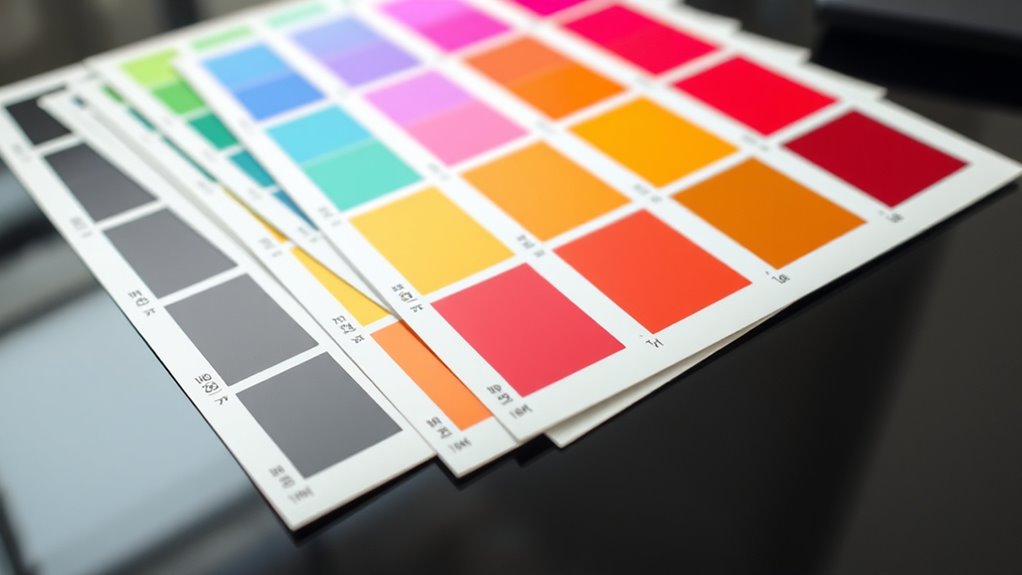
When selecting a CMYK color chart, I focus on color accuracy standards to guarantee consistent results. I also consider media compatibility and the range of colors the chart covers to match my printing needs. Finally, I look at how easy it is to use and whether it suits my specific print process for the best outcome.
Color Accuracy Standards
Choosing the right CMYK color chart hinges on conforming to established color accuracy standards that guarantee consistent and reliable color reproduction. Industry-recognized systems like ISO 12647-2 set the benchmarks for color matching, helping ensure uniformity across different printers and media. Precise calibration is essential, often involving standardized lighting conditions such as D65 or D50, to accurately assess color fidelity. The charts should feature print-tested swatches verified against real-world outputs, confirming their accuracy. Additionally, using measurement tools like spectrophotometers allows for validation against strict colorimetric tolerances, such as ΔE values, ensuring high fidelity. Adhering to these standards minimizes discrepancies, giving you confidence that your CMYK charts truly reflect the colors you aim to reproduce, leading to consistent and professional printing results.
Media Compatibility Factors
Selecting a CMYK color chart that matches your printing media guarantees accurate and consistent color reproduction. It’s essential to verify the chart is printed on media compatible with your process, whether coated or uncoated paper, to reflect true colors. Verify that the ink and paper suit your printing method, such as digital, offset, or screen printing, to prevent color shifts. Consider if the chart supports your media surfaces, like glossy, matte, or textured finishes, which can influence color appearance. Using tested color charts on real-world media ensures CMYK values match your printed output. Additionally, check if the chart provides media-specific data, like ink formulation or lightfastness ratings, to maintain color consistency across different materials. Proper media compatibility is key to achieving reliable color accuracy.
Range of Colors
A thorough CMYK color chart should feature thousands of swatches to guarantee you can accurately match your project’s specific hues. Having a broad spectrum ensures you won’t miss critical shades needed for your work. Look for charts that provide clear CMYK values for each color, enabling precise digital and print reproduction. Including both standard and trending shades keeps your palette versatile and up-to-date. Additionally, a good chart displays color gradations or tints, helping you achieve smooth progressions and nuanced effects. Confirm it covers a wide gamut within the CMYK range to prevent missing essential hues. This extensive color range allows for greater flexibility, accuracy, and consistency across various printing projects, ultimately helping you achieve the best possible results.
Print Process Suitability
To guarantee your CMYK color chart delivers accurate results, it’s crucial to match it specifically to the print process you’re using, whether offset, digital, or flexography. Different printing methods have unique color capabilities and calibration needs, so select charts calibrated for your specific process. Look for charts tested on real-world presses to ensure consistency. Verify the color gamut covers what your printer can produce, avoiding colors outside its range. Additionally, choose charts that specify paper type and coating, like coated or uncoated, to match your final material’s surface. Finally, opt for charts that provide detailed ink formulation data and tint values aligned with your press conditions, ensuring your color reproduction remains precise across different print technologies.
Ease of Use
When choosing a CMYK color chart, ease of use is crucial to streamline your workflow and guarantee accurate color matching. I look for guides with clear, organized layouts that let me quickly identify and compare CMYK values. It’s helpful when charts include both visual swatches and corresponding numerical codes like CMYK, Hex, and RGB, making digital and print references simple. Labeled sections or categories are essential—they help me navigate large color collections efficiently. Features like removable pages, tabs, or color indexing systems further simplify my process, saving time. Most importantly, I prioritize charts that display realistic, print-ready colors, ensuring what I see on the chart closely matches the printed output. This reduces trial and error, making my workflow smoother and more precise.
Material Durability
Since durable CMYK color charts are essential for frequent use, selecting materials that withstand wear and tear is critical. I recommend choosing heavy-weight paper or coated stock, as these materials resist tearing and handle regular handling better. Water-resistant or waterproof coatings offer extra protection against moisture, smudges, and spills, keeping color swatches intact. Thick, high-quality paper reduces warping, creasing, and fading over time, maintaining consistent accuracy. Laminated or plasticized charts provide enhanced durability and are easy to clean, making them perfect for busy print environments. The material choice directly influences the chart’s lifespan, especially when used often. Investing in sturdy, high-quality materials ensures your CMYK color charts remain functional and reliable, providing accurate color matching over the long term.
Cost and Budget
Choosing the right CMYK color chart depends heavily on your budget, as prices can range from under $20 to over $100. Setting a clear budget helps narrow options, ensuring you get necessary color accuracy without overspending. Cheaper charts may have fewer colors or simpler layouts, while premium sets often include extensive color ranges and detailed data. Investing in a quality chart can save money over time by reducing costly printing errors through better color matching. Comparing prices online and offline can reveal the best value, especially when considering shipping costs or discounts for bulk purchases. Ultimately, balancing cost with the level of detail and accuracy you need ensures your investment supports your printing goals without unnecessary expense.
Calibration and Consistency
To guarantee your CMYK color charts provide accurate and reliable references, proper printer calibration is vital. Calibration ensures that the colors you see on your monitor match the final printed output, reducing mismatches. Regular maintenance and calibration prevent color drift across multiple print runs, maintaining consistency. Using standardized calibration tools and following established procedures helps achieve dependable color matching with your CMYK charts. Keep in mind that factors like paper type, ink, and environmental conditions can impact color accuracy, making ongoing calibration essential. Updating calibration settings regularly and verifying color accuracy through test prints are key steps toward consistent results. By prioritizing calibration and consistency, you’ll ensure your color charts remain reliable tools for achieving precise, professional-quality prints.
Frequently Asked Questions
How Do CMYK Charts Differ From RGB Color Charts?
CMYK charts differ from RGB charts because they represent colors in different color spaces. CMYK uses cyan, magenta, yellow, and black inks for printing, focusing on subtractive color mixing, which absorbs light. RGB, on the other hand, uses red, green, and blue for digital screens, relying on additive mixing that emits light. This fundamental difference affects how colors appear and how accurately they translate between digital and print mediums.
Are There Specific CMYK Charts Optimized for Different Printing Substrates?
Yes, there are specific CMYK charts optimized for different printing substrates. These charts are tailored to account for how various papers or materials absorb ink, affect color vibrancy, and influence drying times. I recommend selecting a chart designed for your particular substrate—whether gloss, matte, or textured—to guarantee color consistency and accuracy. By matching your chart to your substrate, you’ll achieve better color fidelity and a more professional final print.
How Often Should Printers Update Their CMYK Color Charts?
I recommend updating your CMYK color charts at least once a year, or whenever you notice color discrepancies or changes in your printing results. Regular updates guarantee your colors stay accurate and consistent, especially if you’re working with different substrates or ink batches. Keeping your charts current helps prevent surprises and maintains the quality you want for your prints, making adjustments easier and more reliable over time.
Can CMYK Color Charts Be Customized for Specific Branding Colors?
Yes, I can customize CMYK color charts for specific branding colors. I work with specialized software and color matching tools to create precise color profiles that reflect your brand’s unique palette. This guarantees consistency across different print jobs and media. Customizing your charts helps maintain your brand’s identity and guarantees that your printed materials look exactly as intended, no matter the project or printer used.
What Is the Best Way to Calibrate Monitors for Accurate CMYK Color Matching?
Did you know that properly calibrated monitors can improve color matching accuracy by up to 90%? To calibrate your monitor for precise CMYK color matching, I recommend using a high-quality calibration device like a colorimeter or spectrophotometer. Follow the device’s instructions carefully, set the correct gamma and white point, and regularly recalibrate to maintain consistency. This guarantees your on-screen colors match printed results closely.
Conclusion
So, there you have it—my top picks for CMYK color charts that promise perfect print color accuracy. Because who doesn’t want their prints to look just like they imagined, right? Just pick one, trust the guide, and hope your printer doesn’t decide to throw a tantrum. Remember, in the world of color, it’s all about matching, not magic—though a little magic never hurts. Happy printing!

